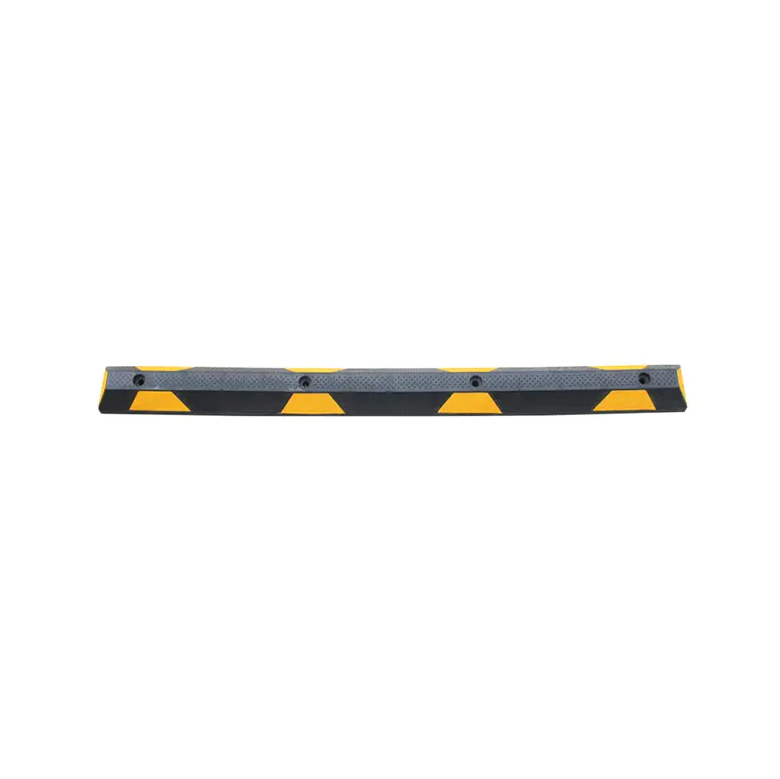Exploring the Factors That Influence the Anti-Slip Efficiency of Parking Chocks Wheel Stops

Parking Chocks Wheel Stops are crucial devices designed to prevent vehicles from rolling beyond designated parking spaces, thus enhancing safety in parking lots, garages, and industrial areas. One of the most important functional aspects of these wheel stops is their anti-slip performance, which determines how effectively they can stay firmly in place and resist vehicle movement. The anti-slip properties of Parking Chocks Wheel Stops directly impact their safety and reliability, making it essential to understand how these devices perform in this regard.
The anti-slip performance of Parking Chocks Wheel Stops depends largely on their design, material composition, and surface texture. Typically, these wheel stops are manufactured from durable materials such as rubber, recycled plastic, polyurethane, or sometimes metal. Among these, rubber and polyurethane are favored for their naturally high coefficient of friction, which enables a strong grip against both vehicle tires and the ground surface. This frictional force is crucial to prevent the wheel stops themselves from sliding out of position when a vehicle applies force.
A key factor enhancing the anti-slip performance is the base design of the Parking Chocks Wheel Stops. Many models feature textured undersides or integrated ridges and grooves that increase surface contact with the ground, thereby reducing the likelihood of displacement. This design consideration is particularly important for outdoor environments, where wet, oily, or uneven surfaces can significantly decrease traction. The presence of these textural elements helps maintain stability even when the parking area is exposed to rain or other adverse weather conditions.
Furthermore, some Parking Chocks Wheel Stops are equipped with bolt holes or mounting provisions that allow them to be securely fastened to the ground. This mechanical fixation offers the highest level of anti-slip performance by physically anchoring the wheel stops in place. In commercial or industrial applications where heavy vehicles are common, bolted wheel stops are preferred because they virtually eliminate any chance of movement caused by vehicle impact or vibration.
Environmental conditions also affect the anti-slip capabilities of Parking Chocks Wheel Stops. For example, surfaces covered with dust, oil, or ice may reduce the friction between the wheel stop and the ground. In such cases, the material’s inherent slip resistance becomes even more critical. High-quality rubber-based wheel stops maintain their grip better than hard plastics, which can become slippery under wet conditions. Additionally, some manufacturers enhance the surface texture or add anti-slip coatings to improve performance on challenging surfaces.
It is also worth noting that the interaction between the wheel stop and the vehicle tire plays a role in anti-slip efficiency. Tires made of soft rubber compounds tend to grip better on the wheel stop, providing an additional layer of safety by preventing the vehicle from sliding forward or backward once stopped. Conversely, worn or hard tires may reduce this grip, though this is less controllable by the wheel stop design.
Maintenance practices further influence the long-term anti-slip performance of Parking Chocks Wheel Stops. Dirt buildup, grease, or worn-down surface textures can compromise friction levels over time. Regular cleaning and inspections help ensure that the wheel stops retain their intended slip resistance and continue to provide effective vehicle restraint.
Place of Origin: Zhejiang, China
Brand Name: Yongsheng
Material: Rubber
Color: Yellow+Black
Size: 1780*150*100 mm
Weight: 14kg
Capacity: 15,000kg
Reflective Film: Glass Bead or Regular reflector
Packing: Woven Bag/Carton
- Art
- Causes
- Crafts
- Dance
- Drinks
- Film
- Fitness
- Food
- Παιχνίδια
- Gardening
- Health
- Κεντρική Σελίδα
- Literature
- Music
- Networking
- άλλο
- Party
- Religion
- Shopping
- Sports
- Theater
- Wellness


